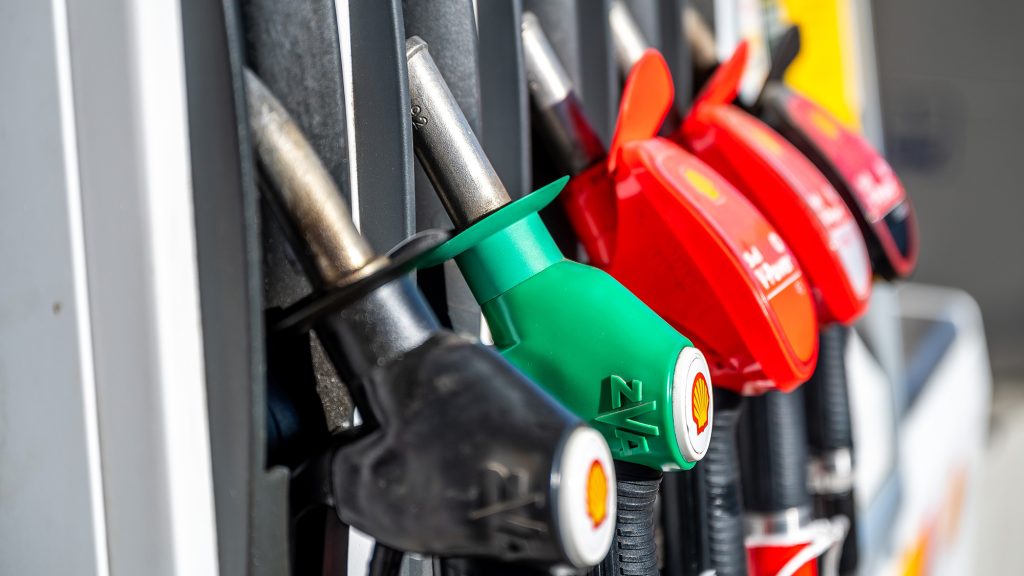Refuelling may have become a frustrating experience for many car owners as fuel gets even more expensive after the 41-forint excise tax raise in January. According to Holtankoljak.hu’s (the website’s name translates to ‘where shall I refuel’) February 1st Data,
- the nationwide average price of 95-octane gasoline was 596.9 forints,
- while diesel was sitting at 631.6 forints.
Examining the data from Hungary’s Central Statistical Office (KSH) for the period between 2019 and 2023 (supplemented with Holtankoljak’s February 1st data), it is evident that refuelling at gas stations now costs significantly more than a few years earlier. The era of the 480-forint price cap is apparent on the graphs, but we have long left that threshold.
The chart also clearly shows that even though on January 15th – in line with EU regulations – the retail market fully incorporated the excise tax, while the Red Sea conflicts still impact oil prices, fuel remains considerably cheaper than a few months ago. In September 2023, for example, fuel stations were charging up to 650 forints for a litre of gasoline, whereas currently, the price hovers around 590 forints.
According to our market source, it is worth examining how much fuel stations would charge in January 2023, right after the removal of the price cap. One year ago, approximately 50 forints more were required per litre of gasoline than in this year’s January, even after the complete integration of the excise tax by the retail market; while regarding diesel, this difference is even greater, almost 90 forints. A year ago, the price per litre of diesel approached the 700-forint threshold, while on January 15, 2024 – even after the excise tax hike – it barely exceeded 600 forints.
Regional Fuel Prices
Hungarian drivers are always keeping their eyes peeled regarding neighbouring countries’ fuel rates – even those not living close to the border – to see if it’s worth crossing over for cheaper fuel. Reports surfaced in January claiming fuel prices would soon get high at the regional level, possibly making a refuelling trip over the border a worthwhile endeavour.
We also examined Holtankoljak’s weekly average fuel rate chart, made available on February 1. When it comes to 95-octane gasoline, only Slovakia and Austria are more expensive than Hungary within the region. Romania, Slovenia, Croatia, the Czech Republic, and Serbia are cheaper to refuel in. Regarding diesel, Hungary ranks sixth among the eight countries, with diesel fuel being more costly only in Serbia and Austria than in Hungary – on average.
It’s challenging to determine fuel station prices in Hungary, as significant differences, amounting to 60-70 forints, can exist nationwide, even within a given chain. Typically, stations located near motorways are significantly more expensive than those at other locations, and this pattern is also typical in neighbouring countries. Additionally, a price level recorded just across the border is not guaranteed to remain the same if one heads further into the given country to refuel,
commented on the pricing issue Ottó Grád, secretary-general of the Hungarian Petroleum Association.
He added that for a provider with stations in a neighbouring country, it might be economically viable to apply lower prices directly across the border due to the higher Hungarian rates, as they could thus expect more traffic coming from Hungary. However, there is no reason to apply these lower prices farther away from the border. Therefore, prices along the border will not necessarily reflect the prices of stations elsewhere, neither will they reliably indicate average prices. Grád emphasised the need to approach price averages and comparisons with caution.
According to our source, Hungarian fuel prices have remained consistently in the regional mid-range, which neither the introduction of excise tax, nor the fluctuations of the national currency could change. Hungarian fuel prices still hover between Czech and Slovak prices, and Hungarian drivers still pay less per litre of gasoline than Slovaks, Serbs, and Austrians. While diesel prices continue to be highest in the Austrian and Serbian retail markets, as indicated in our charts. They went on to add that Hungarian pricing has historically been calibrated between the Czech and Slovak levels but consistently remains below Austrian prices. The consulted experts also mentioned that it is only in the Balkans where fuel is cheaper than in Hungary. Serbia was mentioned as an exception, where the current price regulations make diesel more expensive than in Hungary.
Taxes, taxes, taxes
As Ottó Grád sees it, our regional positions have deteriorated with the January increase in Hungarian excise tax (an additional 41 forints). Fuel prices may be lower in several countries than in Hungary. Sensitivity to exchange rates also affects the pricing. One thing is certain: while last year Hungary stood somewhere in the regional mid-range – with the occasional price fluctuations of certain products – due to the excise tax increase, we are now taking the podium regarding expensiveness, typically aligning with the Austrian and Slovak market price level. Meaning that Hungary’s competitiveness has significantly worsened in this regard – he added.
Before the January 41-forint increase, Hungary had the lowest excise tax in the region, although not even the recent hike could take the country to the forefront. Currently, Hungary is still towards the lower end of the EU rankings, even though the country has moved away from the very bottom. After the increase, Hungarian excise tax is now roughly at the same level as in neighbouring countries, he explained. However, everyone has lower VAT rates than Hungary, and the additional taxes on fuel distribution are also the highest here – several countries have no such taxes at all. These additional taxes (MOL extra profit tax on Russian oil, mining royalties, income tax for energy suppliers, pipeline tax, energy efficiency obligation system, retail tax) impose significant additional tax obligations and create a more complex tax situation in the sector.
Procurement, oil prices, exchange rates, consumption
Ottó Grád suggests that the issue can also be examined from the perspective of oil procurement, although it’s definitely a challenge due to the considerable differences in conditions caused by sanctions and the on-going separation from Russian procurement. Hungary still uses relatively cheap Russian oil for domestic supply, but a significant portion (95%) of the cost advantage must be paid by MOL to the budget in the form of taxes. Consequentially, there is no significant difference in the actual procurement price of oil when compared to other sources. Slovakia however, which – for now – also retains the rights to procure oil from Russia (mainly for domestic use), imposes a much lower tax on the raw material than Hungary does. The Adriatic route, serving as an alternate maritime option, is rather costly along the Croatian section from a logistical perspective. The Austrians use long-distance pipelines without changes; while Czech refineries also partially get their oil through these routes. Poland has been importing a significant share of its raw oil from the North Sea, as permitted by their given conditions; and Romania has been able to get its oil through the Black Sea, so they haven’t really experienced any changes, either.
The starting point for fuel prices is the price point of the global oil market, currently around $80 per barrel and expected to remain in this range in the near future. The exchange rate of the Hungarian forint significantly influences the price, as do the dynamics of supply and demand. Regarding demand, many share a pessimistic outlook, particularly due to the slowdown in the Chinese economy. While a decrease in demand could push prices down, political risks (such as the on-going Russo-Ukrainian war, the Israeli-Palestinian conflict, or a potential escalation in the Red Sea region) could generate significant, immediate price hikes. Domestic prices will follow global market trends, and the recent depreciation of the forint may further increase domestic fuel costs, adversely affecting regional competitiveness, especially compared to countries already using the euro – Grád added.
MOL prices in Hungary and in neighbouring countries
It is equally intriguing to inspect fuel costs at the stations of Hungary’s national oil company, MOL, in Hungary and the surrounding countries where the firm is also operating. Although we inquired at the company itself, they turned down our information request stating that MOL never comments on pricing issues.
Lacking a better alternative, we scoured the internet and based our snapshot on Fuelo.net’s international price averages, converting the figures into forints using the central exchange rate of the Hungarian National Bank. The results showed that on February 1st, at MOL stations in three out of eight countries (Romania, Slovenia, Croatia), gasoline was cheaper than in Hungary. As for diesel, all other countries had lower prices at MOL stations compared to Hungary, except Austria and Serbia.
Intrigued, we sought an explanation. According to our market sources, pricing is based on the principles of competition authorities, and this internationally benchmarked methodology ensures that consumer prices are competition-driven even for MOL, which dominates the domestic wholesale market. The retail market operates as a classic competitive market, where pricing takes into account the prices of domestic competitors as well as the price levels in neighbouring countries.
Any form of price or margin maximization raises concerns about market distortions and supply security issues, as seen previously in Hungary (take for example the price cap), so the market does not favour such practices. However, the existence of any relevant regulations, as well as their nature (margin-based or, for example, procurement value-based) also play a role in pricing decisions. For example, in Slovenia, margin regulation is in place at urban stations, while in Croatia, such a regulation applies at every station (details are reviewed biweekly there). This means that the government determines the maximal margin that can be placed on gasoline/diesel, i.e., the difference between the net procurement and selling prices. Bosnia and Herzegovina still have procurement-value-based regulation, where the government sets the value of fuel per ton. In Hungary, the price cap was eliminated in December 2022.
The quality of fuel can also influence different or similar pricing, as well as the regulations related to bio-components and their cost inclusion, which were also mentioned by our market source as potential factors.
Fuel consumption unlikely to increase this year
According to the latest data from the Hungarian Central Statistical Office (KSH) in November 2023, the volume of fuel station traffic was 21.4% lower than in the same month of 2022, but the annual decline was around 20% for October and September, too. In other words, the expensiveness of fuel significantly reduced demand. But what can be expected from the demand side?
If not for a significant fuel price increase, Ottó Grád does not expect any changes in consumption this year, and he even considers a further decline, albeit small, to be conceivable. This is partly because the fuel consumption of transportation is a significant part of overall fuel consumption, but increasing tax burdens and increasingly uncompetitive domestic prices in the region could pose a significant disadvantage, especially in international transportation. Hence, fewer truckers may opt to refuel in Hungary in the near future.




